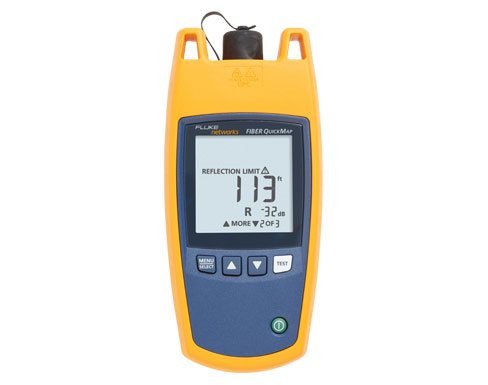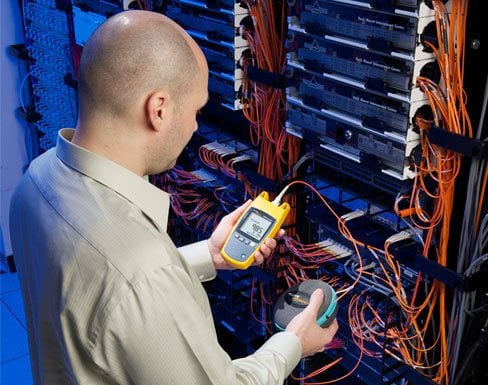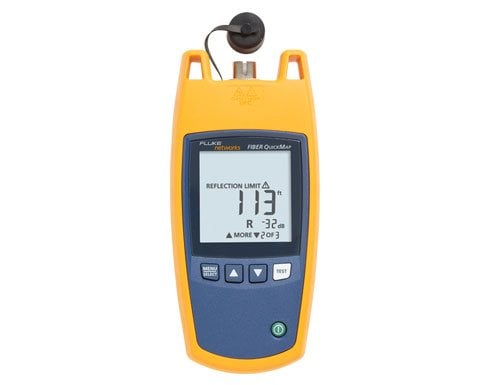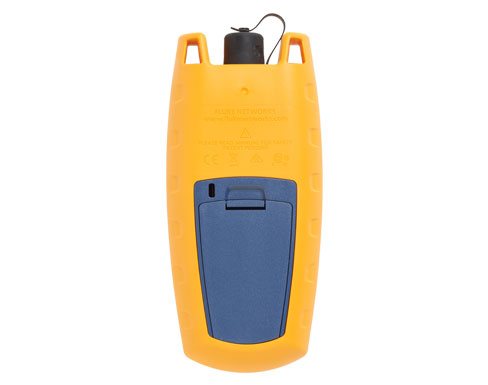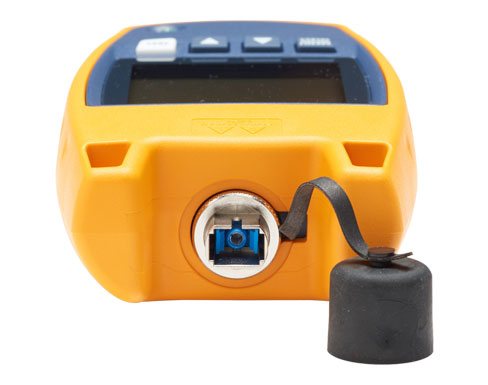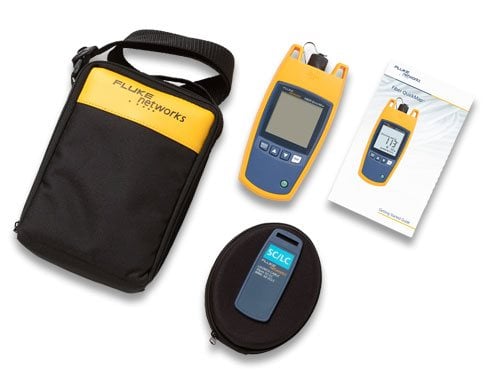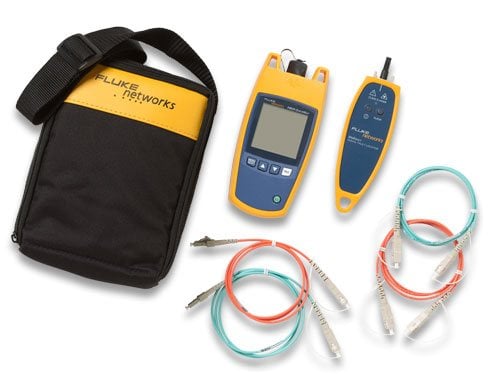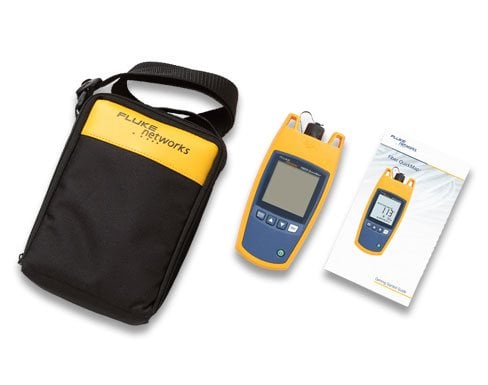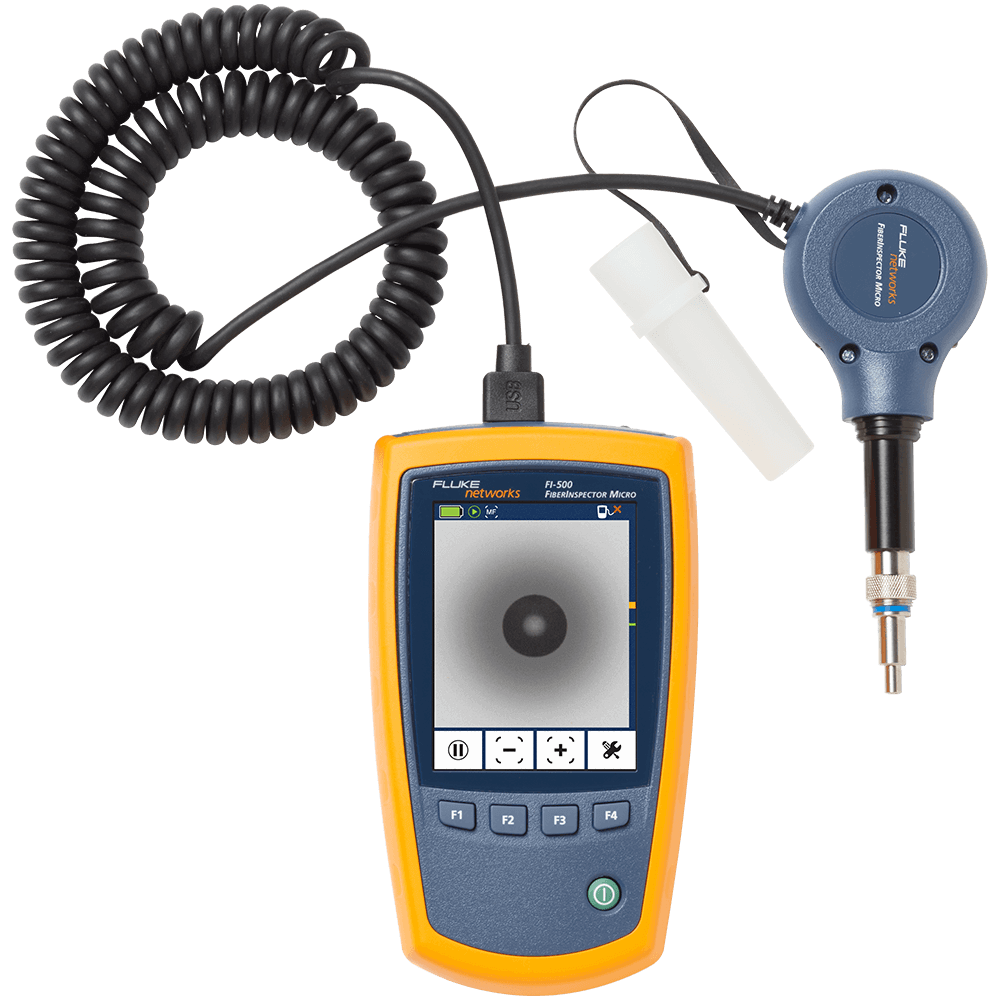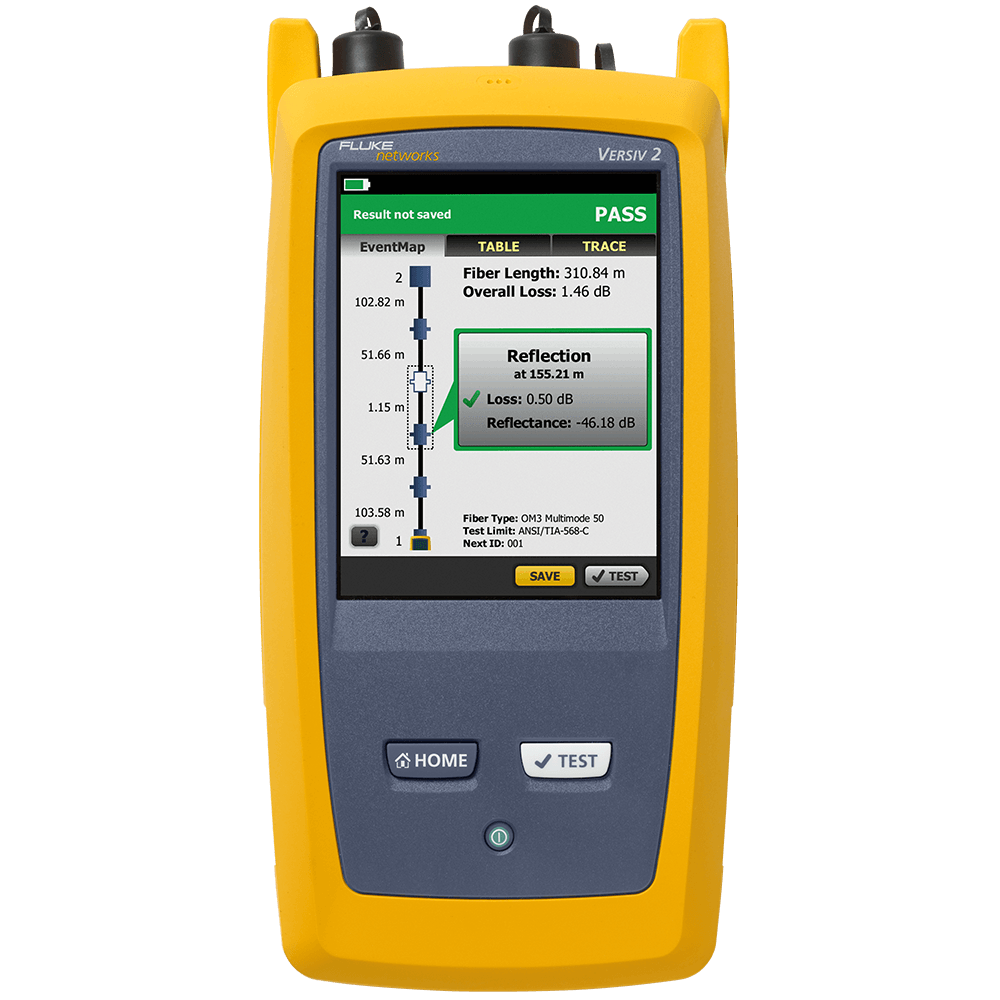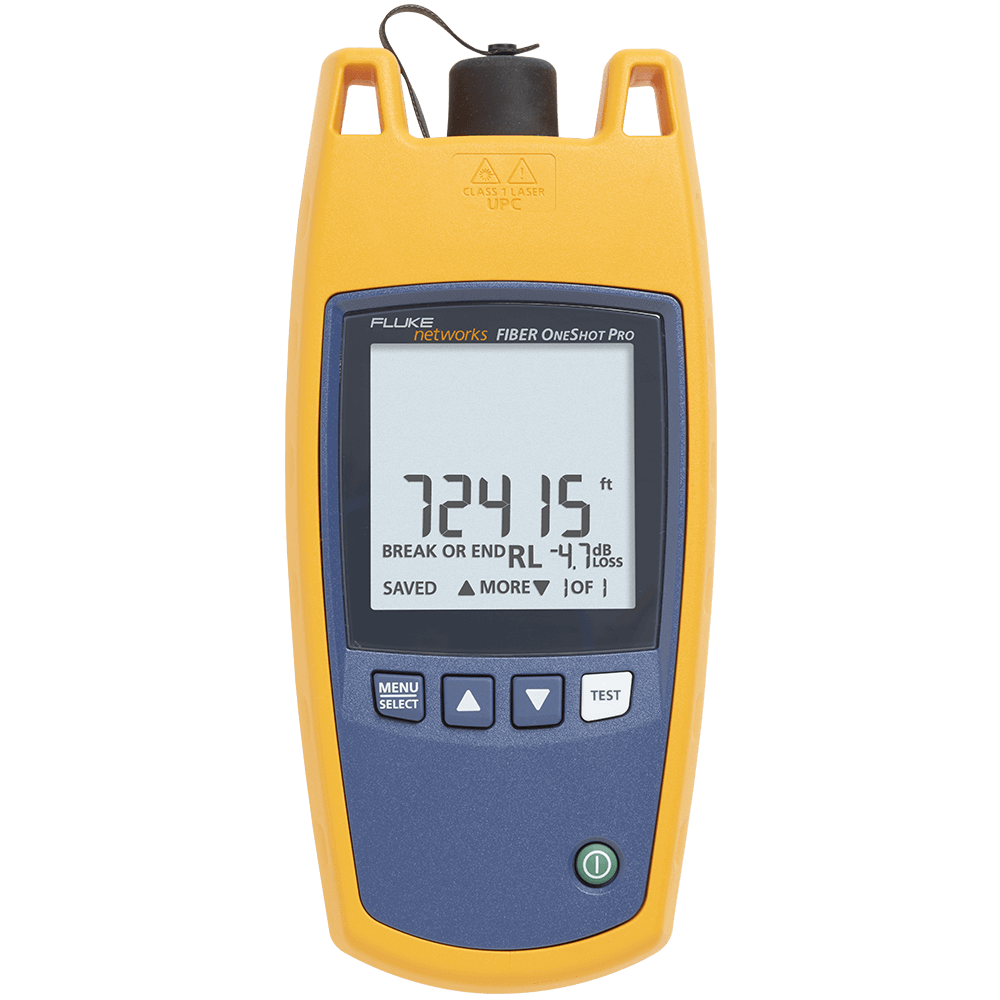Fiber QuickMap™
Product Highlights
Multimode Fiber Distance and Fault Locator
- Works on multimode fiber, 50/125µm and 62.5/125 µm
- 850 nm output wavelength. Measure up to 4,921 feet (1,500 metres) of fiber in seconds
- Locate severe bends, high-loss splices, breaks and dirty connectors in multimode fiber
- Measure and locate high-loss splices
- Locate the end of a fiber View More >
- Find potential sources of high bit error rates caused by reflectance from dirty or poor connections
- Detects live optical signals before it begins testing
- Quick set-up. Connect your fiber and press the Test button. No lengthy set-up necessary
- Find problems quickly. Six-second test time—no more blind troubleshooting that can waste hours
- Change the Index of Refraction (IOR) to improve fiber length accuracy
- Visible in dark areas. Backlighted display turns off automatically
- Removable SC adapter is easily cleaned
- Optional LC, ST and FT interchangeable adapters are available
- Long battery life, 1,500 tests (typical) from 2 AA alkaline batteries
- Rugged construction; vibration and drop tested to 1 meter
PRODUCT NAVIGATION
Overview
VFLs work well for exposed lengths of fiber near a patch panel by illuminating bad connections and breaks. They are not very helpful for cable runs more than a few meters, or when the cable not visible or accessible, or when the laser light can’t penetrate the jacket.
Optical Time Domain Reflectometers (OTDR) provides graphical data and analysis along the entire length of a cable, way beyond the reach of a VFL, but they can be expensive and require more time to and skill to operate.
Fiber QuickMap fills the gap between a VFL and an OTDR. These models have the simplicity of a VFL, and provide distance and power information on high losses, breaks, and the end of the fiber. They also identify live fiber
Features
While connector reflectance is a normal phenomenon in fiber cabling, too much of it can actually cause problems, especially within high bandwidth (10+ Gbps) systems. Excessive reflectance (usually caused by dirty end-faces or poor polishing) interferes with transmitter output, resulting in bit-error issues. Being able to locate and measure high reflective incidents helps to optimize network performance.
Discovering high loss incidents within a multimode channel is critical because they are the source of most enterprise fiber failures. These macrobends, contaminated, or damaged fiber end-faces that can create high loss are invisible to visual fault locaters, flashlights, and power meters. With a Fiber QuickMap, however, the user can quickly define loss thresholds to flag and locate any incidents of high loss.
Having visibility into all the connection incidents within a channel is imperative because they are where most fiber failures in enterprise environments occur. The Fiber QuickMap troubleshooter will display the distances to multiple* connection incidents all the way until the end of (or break in) the link.
* A maximum of nine incidents can be displayedFiber QuickMap can be used straight out of the box with no user-setup required. Simply turn it on, connect to the multimode link to be tested, and press the “TEST” button to obtain the channel visibility you need in order to quickly troubleshoot or verify connectivity. No need to fiddle with settings, fiber types, or standards.
The Fiber QuickMap troubleshooter, as a single-ended instrument, cuts down your troubleshooting time from hours to mere seconds. Averaging six seconds of test time, it quickly provides the visibility and data necessary to locate and fix any issues with your multimode fiber cabling. Tools normally used for troubleshooting are typically inefficient, ineffective, or both. Visual fault locators, lasers, or flashlights, while easy to use, have extremely limited troubleshooting capabilities because they are unable to distinguish or locate problematic loss or reflective incidents. They also require that the user maintain visual contact with the cabling while tracing its length to locate any faults. Not only is this process time-intensive, it is also unrealistic in many data center and campus environments in which the links run underneath floor tiles, behind walls, or underground. Power meters and sources are great for testing the entire channel to verify power and loss, but are inefficient for troubleshooting because the user must sequentially test a channel link-by-link, which can take several hours depending on the length of the channel and the number of links.
Models & Accessories
Models
FQM-100-M Gold Support
Includes multimode fiber fault locator unit, screw on interchangeable SC adapter, 50 µm SC/LC Multimode Launch Fiber, carrying case, 4-language Quick Reference Guide (manuals in 9 languages available on-line), safety instruction manual, and batteries See Photo
GLD-FQM-100-M
1 YR Gold Support for FQM-100-M
FQM-100-M-VFL Gold Support
Includes multimode fiber fault locator unit, screw on interchangeable SC adapter, UPC-UPC 2-meter patch cord, carrying case, 4-language Quick Reference Guide (manuals in 9 languages available on-line), safety instruction manual, and batteries. VisiFault Visual Fault Locator with 2.5 mm universal adapter is also included See Photo
GLD-FQM-100-M-VFL
1 YR Gold Support for FQM-100-M-VFL
FQM-SFP-M Gold Support
Includes multimode fiber fault locator unit, screw on interchangeable SC adapter, UPC-UPC 2-meter patch cord, carrying case, 4-language Quick Reference Guide (manuals in 9 languages available on-line), safety instruction manual, and batteries. SimpliFiber Pro optical power meter, multimode light source, and SC adapter are also included See Photo
GLD-FQM-SFP-M
1 YR Gold Support for FQM-SFP-M
Accessories
Multimode launch cable 50 µm SC/LC
MULTIMODE LAUNCH CABLE 50µm LC/LC
Multimode launch cable 62.5 µm SC/LC
MULTIMODE LAUNCH CABLE 62.5µm LC/LC
Specifications
Models
Operating temperature with the battery
0ºC to 50ºC
Non-operating temperature
-20ºC to 60ºC
Operating relative humidity (without condensation)
95% (10ºC to 35ºC) 75% (35ºC to 40ºC) uncontrolled < 10ºC
Vibration
Random, 5 Hz to 500 Hz, MIL-PRF-28800F CLASS 2
Shock
1 meter drop test
Altitude
3000m
EMC
EN 61326-1: 2004
Battery type
2 AA alkaline batteries (no battery charger)
Battery life
1500 tests (typical)
Laser safety
Class 1 CDRH Complies to EN 60825-2
LCD type
Backlit black and white (segments)
Index of refraction range
1.45 to 1.5 (factory default is 1.496)
Auto turn off
Automatically turns off after 5 minutes if no keys are pressed. Backlight turns off first.
Factory calibration interval
None
Output wavelengths
850 nm ± 10 nm
Laser classification
Class 1 CDRH Complies to EN 60825-2
Dynamic range
>11 dB
Maximum distance
1500 meters or 4921 feet
Maximum number of incidents shown
9
Distance accuracy (0 m to 1500 m or 0 ft to 4921 ft)
± (1 m + 0.1 % x length) for reflective incidents1 ± (3 m + 0.1 % x length) for non-reflective incidents2
Testing speed
< 6 seconds typical
Connector
Removable/cleanable SC adapter, UPC polish
Fiber types tested
50/125 µm or 62.5/125 µm multimode
Detection of reflective incidents3
-35 dB default threshold (User selectable: -20 dB to -45 dB in 5 dB increments)
Reflectance accuracy4
± 4 dB
Maximum reflectance measurement
-20 dB
Detection of loss incidents5
0.70 dB default threshold (user-configurable from 0.5 dB to 6.1 dB in 0.2 dB increments)
Bulkhead quality
If no fiber is attached or if the connector is dirty, the troubleshooter displays 0 m or 0 ft.
Live fiber detection
Detects optical signals from 600 nm to 1050 nm and shows ACTIVE LINE if a signal is there. Looks for a signal every 3 seconds after the first detec-tion. +7 dB maximum input power.
Certifications and compliance
 Conforms to relevant European Union
Conforms to relevant European Union
directives
 Conforms to relevant Australian standards
Conforms to relevant Australian standards
 Listed by the Canadian Standards Association CSA
Listed by the Canadian Standards Association CSA
C22.2 No. 61010.1.04
 Conforms to FCC Rules, Part A, Class A
Conforms to FCC Rules, Part A, Class A
1. ± user-configurable Index of Refraction (IOR) error ± the incident location error. Incident location error for reflective incidents: ±1 m from 1 m to 1.5 km.
2. ± user-configurable Index of Refraction (IOR) error ± the incident location error. Incident location error for non-reflective incidents: ±2 m for lengths £15 m, otherwise ±1 m.
3. Finds and gives the location of an incident that has a reflectance larger than -55 dB. Detects incidents >1m after the bulkhead connector when the bulkhead reflectance is <35 dB. Detects incidents >3 m after an incident when the incident reflectance is <35 dB.
4. With a backscatter coefficient of -63 dB at 850 nm using a calibrated -14 dB reference.
5. Detects incidents >10 m after the bulkhead connector or any prior incident when the bulkhead reflectance is <-35 dB and the reflectance of any prior incident is <-35 dB. The maximum link loss prior to the incident is <7 dB.
Documents
Request your 4” x 6”, sturdy pocket guide that is ideal to take on all your fiber jobs. Includes a quick-action summary and checklist, this guide is an invaluable tool to ensure you never miss a critical step during your fiber testing or troubleshooting.

